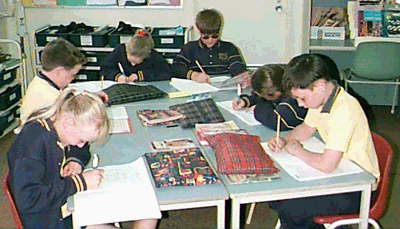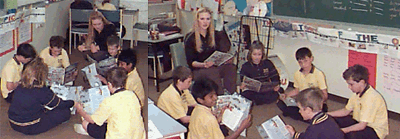Early Years Literacy in Year 3 and 4.

Here is a simple guideline to the structure of Early Years Literacy into Years 3 and 4. I have found it easier to complete the reading block and then the writing block. The key to keeping children interested in their literacy is to keep it interesting and fun. As soon as you find the activities repetitious, chances are the children do to, so create new and interesting ones. Information technology should be linked with at least one of your group activities. It doesn't necessarily have to be in the same 'type' of activity each week, but it needs to be incorporated into one of them at least. One thing you must always have in the back of your mind is, 'Are the activities suited to each child at their level?' This is one of the major focusses of the Early Years Literacy, which also should be the focus of any skillful teacher.
I have 4 reading groups in my literacy activities that works well for me. I have them levelled according to their abilities, although the children don't realise this. I ask the children to read for at least 15 mins each night and have them bring in a signed reading log (Microsoft Word format) everyday. You would be amazed how this has improved some of their reading. The children also have a spelling word table (Microsoft Word format) in which they place words from all their writing so they are learning words that are relevant to them. These words are then attached to the weekly spelling word list.
Reading
First 15 mins is silent reading.
GROUPS

1. Reading group. Teach a certain text type to the children. Try to relate it to the Integrated Studies topic.
This reading group consists of guided reading or reciprocal reading.
Magazines.
Newspapers.
Dialogue from something.
Books.
Posters.
The list is endless.
2. Word Study. Activities for their spelling words or other activities.
Roll a dice and find all the word you can with those letter in them, eg. ee, ie, th.
Go through the book they are reading and write out all the words in their simplified form that end in 'ing', 'ed', ''s'.
The children will often find something interesting to tell us about what they find, eg, 'ing' have the 'e' chopped off.
Write out spelling words in different pens, glitter pens, write the words in paste and then dip the paper in sand, cut out letters of each word from magazines.
Go through their book and write out all the words the author used instead of, said, they, etc.
Create a crossword or word-a-find with their words.
Get the children to think up their own activity to incompass their spelling words. This activity is best completed when you know the children and the children know you!
There is a great reference book that l use to create my spelling activities. Refer to the reference list.
You need to make sure that this activity is levelled according to the children's needs. I do this via a card system, each group of children know which number cards they are to retrieve work from. They don't realise this activity is levelled which works well for some of the children's confidence.
Spelling patterns (Microsoft Word format)
3. Comprehension or Cloze.
Reader's theatre.
Comprehension cards. Refer to resources list.
This is a good type of activity to incorporate information technology as you can produce a read only file for the children to access.
4. Response to text.
Write a new ending for their book.
Draw a picture of their favorite part of the book.
Poem about the book.
Book review.
Read a newspaper article and summarize it. Write a letter to the editor.
Write a letter to a friend about the book you have just read.
Picture sequence of the book in cartoon form.
Bookmark.
New dust cover.
Rewrite ending.
Create a newspaper article advertising the book, illustrate it.
Mobile of the characters.
What l have found works well and caters for the different learning styles within a classroom is giving the children a checklist. The children then work on whichever activity they wish to complete first and mark it off on the checklist. This is just a reminder to them what they have completed within the week and also giving them the opportunity to take charge of their own learning. The only activity they don't choose which day they complete it is the reading group activity.
Chn literacy checklist (Microsoft Word format)
Writing
A teaching group where you teach a specific writing technique to a certain group of children.
OR
A whole class teaching session. This should only be about 10 mins.
There are no groups in this 1 hour block. Longer time better writers.
Activities
List all the things you know lots about and then write about them.
Focus on them writing for all the text types, but must have been taught in guided reading beforehand. Good book for reference is 'Targeting Text'.
Story starter sheets.
A box with pictures in it. The children go to the box and choose a picture for a visual jogging of ideas.
Journal writing about things in the news.
Handwriting practice.
Teach how to plan a story and model the whole process and then they go and do it.
Research something of the Internet to do with the Integrated Studies unit, in a group, and present it to the class.
Sharing time at the end. About 5-10 mins. |



